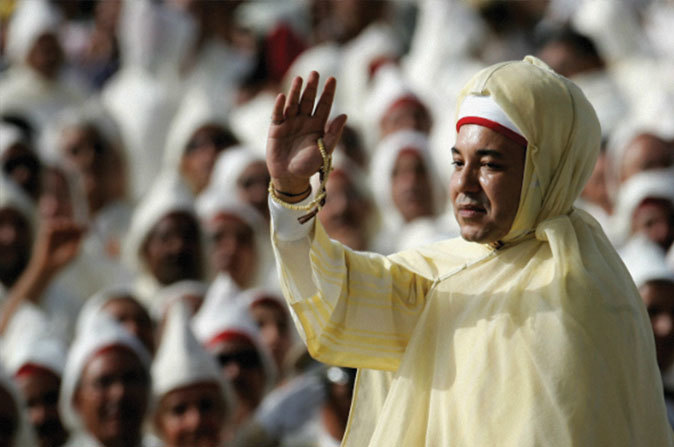Economy / Morocco
Explaining an exception
In the past two years, the Kingdom has achieved a turnaround on a political as well as an economic and social level. Despite the economic crisis in Europe, Morocco continues to attract investment especially from the Gulf countries.

HM King Mohammed VI waves to crowd of men dressed in traditional white robes during Throne Day Celebrations at the Royal Palace
The Moroccan exception is more than a mere slogan. It is confirmed year after year on an economic, social, political and cultural level. Despite the global financial crisis, the Kingdom can expect a growth rate of 4.8% in 2013, according to the High Commission for Planning. The country has become a particularly attractive proposal for investors. In 2012, Morocco became the second African destination for direct foreign investment, right behind South Africa and ahead of Kenya. Morocco thus managed to unseat its rivals and attain the rank of ‘African country of the future’ in 2011/2012, a title given by the Financial Times.
A stone’s throw from Europe across the Strait of Gibraltar and ensconced in Africa, Morocco is a reassuring gateway into an enormous and diverse market. Its appeal among foreign investors is also explained by the country’s exceptional stability, intrinsically related to its political system. The King is loved by his people and, as a member of the Cherifian dynasty, his legitimacy is unquestioned by all Moroccans. The institutional reforms undertaken by HM the King have been hailed as a success. In the words of David Hobbs, Secretary General of the NATO Parliamentary Assembly: ‘Morocco has proved that a country can evolve serenely while successfully carrying out its reforms’.
The Moroccan exception can also be justified by the choice of an economic model geared towards integration with the global economy. Since Morocco cannot rely on oil or gas reserves, it has no alternative but to open up. Proof of this are the free trade agreements allowing it to export to a market of over 55 countries, adding up to 1 billion consumers. The challenge lies in making the country a financial and commercial platform within the region.
Going further
There is a need to increase the impact of reforms as a catalyst for private investors. Weaknesses remain in the business environment, especially SMEs, in areas that require significant public agency coordination, and where a gap remains between the laws and their application. While sector-specific and industrial development plans are in place (National Pact for Industrial Emergence, Morocco Export Plus, Green Morocco Plan in Agriculture, Halieutis Plan and Vision 2015 for craft) and Morocco has adopted an ambitious Free Trade Agreement (FTA) agenda, some areas of trade policy remain weak. Financial sector reforms have been impressive in Morocco, but there is room to further improve domestic Small and Medium Enterprises’ (SMEs) access to credit.
In the wake of the Arab Spring
The period after the Arab Spring has confirmed the notion of the Moroccan exception. Out of all the countries that experienced social upheavals, Morocco was one of the few that succeeded in stemming the tide of dissent. The secret was to engage in the social debate and break down taboos before tackling the reforms. ‘Its new constitution has allowed the Kingdom to strengthen the role of the head of government, the parliament and public institutions. At the same time, there has been a redefinition of the relationship between citizens and rulers and a separation of powers. The Monarchy acts as a mediator in the broad-ranging strategic decisions and in sensitive social issues, such as the reform of the media, the Family Code or the status of women’, states Nizar Baraka, recently named Finance Minister of the Year 2012 and Best Finance Minister in the Middle East and North Africa (MENA) region by The Banker magazine.
These achievements have been crowned by transparent legislative elections with universal suffrage. The result was the Benkirane government, backed by the polls and steered by the moderate Islamists of the Justice and Development Party (PJD).
Affinities with the Persian Gulf
All these factors make this country of more than 30 million people a partner of choice for the Middle East. Morocco was already a preferential partner of the Gulf Cooperation Council (GCC) countries: the visit by HM King Mohammed VI to the Middle East in 2012 strengthened those ties and added a new dimension to economic cooperation.
The close relationship with the UAE, already linked to Morocco by a free trade agreement, is apparent. Emiratis are present in the housing and tourism markets through large investment projects, as well as in the energy market, especially through the Jorf Lasfar power plant. Through the project to build a high-speed train link between Casablanca and Tangier, Saudi Arabia has also become a special partner. In addition, a Saudi consortium has recently won the bid for the contract to build a 160 MW solar power plant in Ouarzazate, at an estimated cost of $1 billion.
The countries of the GCC have decided to confirm their support to Morocco by granting a total of $5 billion in aid over five years. These funds will be used to finance several structural development projects. For Morocco, the long-term challenge lies in becoming a full member of the GCC despite the geographical distance. Will the country eventually manage to confirm this affinity through a unified vision? For the time being, Moroccans are placing high hopes in the closer relationship with one of the few economic areas in the world that has avoided the crisis.
